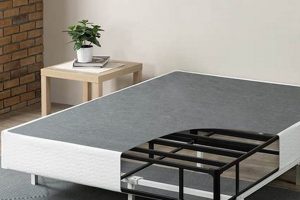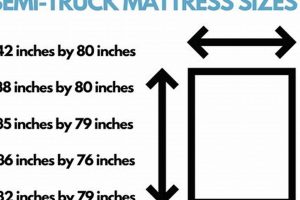An RV queen mattress, while sharing the “queen” designation, generally differs in dimensions from a standard residential queen mattress. Typically, it measures around 60 inches wide but its length is often shorter than the standard 80 inches, frequently being closer to 75 inches or even 74 inches. This size accommodation is essential to fit within the confined spaces of recreational vehicles.
The prevalence of this modified size stems from the practical needs of RV design. Maximizing living space within a mobile dwelling necessitates strategic use of every inch. A shorter mattress allows for more walkway, cabinetry, or other functional elements within the RV’s interior. The dimensions are a trade-off between sleeping comfort and overall spatial efficiency.
Understanding these size differences is crucial for selecting appropriate bedding and ensuring a comfortable sleeping experience. Prospective RV owners or those looking to replace an existing mattress should carefully measure the available space before making a purchase to guarantee a proper fit and avoid unnecessary complications.
Tips for Understanding RV Queen Mattress Dimensions
Selecting the correct mattress for a recreational vehicle requires careful consideration of space constraints and specific needs. The following tips provide guidance for navigating the nuances of RV queen mattress sizes.
Tip 1: Measure Accurately: Prior to any purchase, precisely measure the existing mattress platform or the available space in the RV bedroom. Account for any obstructions or built-in features that may impact mattress fit.
Tip 2: Confirm the Length: While the width is typically 60 inches, the length of an RV queen mattress is often shorter than a standard queen. Verify the length dimension, which can range from 74 to 75 inches, depending on the manufacturer and model.
Tip 3: Consider Mattress Thickness: Mattress thickness influences overall comfort and headroom within the RV. Thicker mattresses may reduce available space, while thinner options may compromise support. Evaluate personal preferences and RV space limitations when selecting mattress depth.
Tip 4: Research Manufacturer Specifications: Mattress manufacturers often provide detailed specifications, including exact dimensions, construction materials, and warranty information. Consult these specifications to ensure compatibility with the RV and to understand the mattress’s features.
Tip 5: Check for Custom Options: If standard RV queen dimensions do not suit the specific requirements, explore custom mattress options. Some manufacturers offer tailored solutions to accommodate unique spaces or individual preferences.
Tip 6: Evaluate Weight Considerations: The weight of the mattress is an important factor in RV weight management. Heavier mattresses can impact fuel efficiency and overall RV performance. Opt for lighter materials or designs to minimize added weight.
Tip 7: Factor in Bedding Availability: RV queen mattresses may require specialized bedding sizes. Confirm the availability of sheets, blankets, and mattress protectors that are compatible with the specific dimensions of the RV queen mattress.
By adhering to these tips, RV owners can confidently select a mattress that provides optimal comfort and fits seamlessly within the confines of their recreational vehicle.
Careful planning and attention to detail will contribute to a more enjoyable and restful travel experience.
1. Standard Width
The consistent 60-inch width of an RV queen mattress serves as a foundational element in defining its overall size. This dimension dictates the lateral space occupants will have and influences bedding compatibility. Deviation from this width would necessitate custom bedding solutions and could significantly alter the interior layout considerations within the recreational vehicle.
- Occupancy and Comfort
The 60-inch width accommodates two adults reasonably comfortably. This standard allows for adequate personal space during sleep, contributing to rest quality. Reductions in width compromise individual comfort, potentially leading to disturbed sleep patterns and reduced occupant satisfaction during travel. The standard width is a direct determinant of the bed’s occupancy capacity.
- Bedding Availability and Cost
The standardized 60-inch width simplifies the process of acquiring fitted sheets, blankets, and mattress protectors. Standard sizing ensures broader availability and competitive pricing. Non-standard widths require custom-made bedding, incurring higher costs and potentially longer lead times. This economic factor often reinforces adherence to the 60-inch width among RV manufacturers and owners.
- Spatial Efficiency in RV Design
RV design hinges on optimizing interior space. The 60-inch width allows manufacturers to balance sleeping comfort with usable floor space. Altering this width impacts aisleways, storage capacities, and other functional areas within the RV. Consequently, any modification necessitates a reassessment of the entire floor plan to maintain usability and accessibility.
- Compatibility with Aftermarket Accessories
Various aftermarket accessories, such as mattress toppers, electric blankets, and bed frames, are designed for standard queen-sized mattresses. Maintaining the 60-inch width ensures compatibility with these products, offering RV owners a broader range of customization options. Non-standard widths limit accessory choices and may require modifications or custom solutions.
In conclusion, the 60-inch width represents a carefully considered balance between comfort, practicality, and economic factors. Its role extends beyond a simple measurement, influencing various aspects of RV design and ownership. Adherence to this standard contributes to the overall functionality and user experience within the mobile living space.
2. Typical Length
The reduced length, typically 74-75 inches, is a defining characteristic distinguishing the RV queen mattress from its residential counterpart, and is central to understanding its size. This length modification directly responds to the spatial constraints inherent in recreational vehicle design. The effect of this shortened length is twofold: it allows for optimized use of interior space within the RV, and it necessitates careful consideration when selecting bedding, as standard queen-sized sheets will not fit appropriately. For example, an RV manufacturer may prioritize a longer galley or bathroom area by reducing the sleeping area’s length, which in turn mandates the use of a shorter mattress.
This dimension is not arbitrary; rather, it reflects a deliberate compromise between sleeping comfort and the efficient utilization of limited space. In practical terms, the shortened length impacts the sleeping experience, particularly for taller individuals. While the 60-inch width remains consistent with a standard queen, the reduced length can lead to discomfort if the occupant’s feet extend beyond the mattress edge. This necessitates potential buyers to measure their own height against the mattress length to ensure sufficient comfort. Furthermore, understanding this length discrepancy is paramount when ordering custom RV mattresses or seeking aftermarket bedding solutions.
In summary, the 74-75 inch length is a crucial component that defines the RV queen mattress size. This length directly influences spatial efficiency within the vehicle, affects occupant comfort, and dictates the compatibility of bedding options. Ignoring this dimensional difference can lead to purchase errors, spatial inefficiencies, and compromised sleeping experiences. Awareness and accurate measurement are, therefore, essential for selecting an appropriately sized RV queen mattress.
3. Thickness Variability
Thickness variability in RV queen mattresses directly influences not only comfort but also spatial dynamics within a recreational vehicle. The vertical dimension of a mattress impacts headroom, storage capacity, and overall ergonomic considerations within the often-confined environments of RVs.
- Headroom and Accessibility
A thicker mattress reduces the vertical space between the sleeping surface and the ceiling, potentially impacting ease of movement and comfort, especially for taller individuals. Conversely, a thinner mattress can increase headroom, but may compromise support and pressure relief. Selection must balance vertical space constraints with individual comfort needs. An example would be an RV with overhead storage compartments above the bed, where a thicker mattress would limit accessibility to the compartments.
- Storage Compartment Capacity
If the bed platform incorporates under-bed storage, the mattress thickness directly affects the available volume. A thicker mattress reduces the height of items that can be stored beneath, limiting the functionality of the storage space. Therefore, matching mattress thickness to the storage requirements is paramount. Some RV designs prioritize under-bed storage, necessitating thinner mattresses to maximize capacity.
- Weight Considerations
Thickness often correlates with mattress weight, with thicker mattresses typically being heavier due to increased material density. Excess weight can negatively impact fuel efficiency and the overall handling of the RV. Therefore, a balance must be struck between desired comfort levels and the practical considerations of weight management. A thicker memory foam mattress, while providing superior comfort, will invariably weigh more than a thinner innerspring alternative.
- Bed Frame Compatibility
The height of the RV bed frame or platform must be considered in conjunction with mattress thickness. A thicker mattress on a high platform may result in an excessively high sleeping surface, making it difficult to get in and out of bed. Conversely, a thin mattress on a low platform may feel uncomfortably close to the floor. Proper integration between mattress and bed frame heights ensures optimal ergonomic positioning. Some RVs have adjustable bed frames to accommodate varying mattress thicknesses.
The interplay between these elements reveals that mattress thickness should not be considered in isolation but as part of a holistic approach to RV design and comfort. Accurate measurement, an understanding of spatial limitations, and awareness of personal preferences are all critical components of informed mattress selection within the context of RV ownership.
4. Corner Radius
The inclusion of a corner radius within the specifications of an RV queen mattress represents a departure from the traditional rectangular form factor and has implications for both spatial efficiency and comfort. This design modification addresses the frequent presence of curved walls and built-in structures within the confined interiors of recreational vehicles.
- Accommodation of Interior Contours
Many RV designs incorporate curved walls, cabinetry, or other structural elements to maximize interior space and aesthetic appeal. A mattress with a corner radius allows it to fit snugly against these contours, preventing gaps and optimizing the use of available space. Without a corner radius, a rectangular mattress may require forcing into a non-rectangular space, potentially causing damage to the mattress or surrounding structures. This is particularly relevant in custom RV builds where non-standard shapes are more common.
- Enhanced Walkway Clearance
By conforming to the shape of the RV’s interior, a mattress with a corner radius can improve walkway clearance around the bed. This is especially beneficial in smaller RVs where every inch of space is critical for maneuverability. The curved corner allows for a smoother transition between the bed and the surrounding area, reducing the risk of bumping into sharp corners and enhancing overall safety within the confined space.
- Custom Bedding Considerations
The presence of a corner radius necessitates the use of specialized bedding. Standard rectangular sheets may not fit properly, resulting in bunching or pulling. Manufacturers offer fitted sheets specifically designed for mattresses with rounded corners, ensuring a snug and secure fit. This requirement for specialized bedding can add to the overall cost of ownership, but is essential for maintaining both comfort and aesthetic appeal.
- Impact on Sleeping Surface Area
A mattress with a corner radius inherently reduces the overall sleeping surface area compared to a rectangular mattress of the same nominal dimensions. While the reduction in area may be minimal, it can impact comfort, particularly for individuals who prefer to sleep near the edge of the bed. The design trade-off balances enhanced spatial efficiency with a slight compromise in usable sleeping surface.
In conclusion, the corner radius element of an RV queen mattress underscores the importance of considering nuanced design features in the context of specialized environments. While offering advantages in terms of spatial integration and maneuverability, it also introduces considerations related to bedding compatibility and sleeping surface area. Careful assessment of these factors is necessary for making informed purchase decisions.
5. Weight Consideration
Weight consideration is intrinsically linked to mattress dimensions in the RV context, as total mass directly influences fuel efficiency and handling characteristics. A heavier mattress, resulting from increased thickness or denser materials, contributes to the overall vehicle weight. This, in turn, increases fuel consumption and potentially diminishes braking performance. Selecting an RV queen mattress necessitates a careful balance between desired comfort levels and the constraints imposed by weight restrictions. For instance, while a thick memory foam mattress might offer superior comfort, its increased weight could significantly impact the RV’s gas mileage and payload capacity. Consequently, RVers often opt for lighter materials, like latex or specialized foams, to mitigate these effects while maintaining adequate comfort levels.
The relationship between weight and dimensions also extends to the structural integrity of the RV itself. Overloading a vehicle beyond its specified weight limits can stress the chassis, suspension, and tires, leading to premature wear or even catastrophic failures. Therefore, knowledge of a mattress’s weight, in conjunction with the dimensions of the sleeping area, enables RV owners to make informed decisions, preventing damage and ensuring safe operation. As an example, if the RV’s bed frame is elevated with storage underneath, a heavier mattress could put undue strain on the supporting structure, potentially causing it to weaken over time. This underlines the importance of cross-referencing mattress weight with the RV’s specifications.
In summation, weight considerations are an integral component when determining the appropriate dimensions for an RV queen mattress. The trade-off between comfort, material density, and overall vehicle performance requires careful evaluation. Understanding the impact of mattress weight on fuel efficiency, vehicle handling, and structural integrity is paramount for safe and efficient RV travel. Prioritizing lighter materials and designs, alongside accurate measurement and weight calculations, enables RV owners to maximize comfort without compromising the functionality and longevity of their vehicle.
Frequently Asked Questions
The following questions address common inquiries regarding the specific dimensions and characteristics of RV queen mattresses, essential for ensuring comfort and optimal space utilization within recreational vehicles.
Question 1: Are RV queen mattresses the same size as standard residential queen mattresses?
No, an RV queen mattress typically differs in length from a standard queen. While the width is generally consistent at 60 inches, the length is often shorter, usually measuring 74-75 inches compared to the standard 80 inches.
Question 2: Why are RV queen mattresses shorter than standard queen mattresses?
The shortened length optimizes space within the often confined interiors of recreational vehicles. This design prioritizes maximizing living area, walkways, and storage capabilities.
Question 3: Will standard queen-sized sheets fit an RV queen mattress?
Standard queen-sized sheets may not fit properly due to the reduced length of an RV queen mattress. Excess fabric may bunch or require tucking, which can be uncomfortable. Purchasing sheets specifically designed for RV queen mattresses is recommended.
Question 4: Is mattress thickness a significant consideration for RV queen mattresses?
Yes, mattress thickness directly impacts headroom, under-bed storage space, and overall weight. Thicker mattresses reduce headroom, while impacting weight. Selecting a thickness appropriate for the RVs dimensions and weight capacity is crucial.
Question 5: What is a corner radius, and why might it be present in an RV queen mattress?
A corner radius refers to the rounded corners sometimes incorporated into RV mattresses. This design accommodates curved walls and maximizes usable space in RVs with non-rectangular interiors.
Question 6: How does mattress weight affect RV performance?
Increased mattress weight contributes to the RVs overall weight, which can negatively impact fuel efficiency and handling. Selecting lighter materials helps mitigate these effects and preserves the RV’s operational performance.
Understanding the specific dimensions and attributes of RV queen mattresses facilitates informed purchasing decisions, ensuring comfort and maximizing functionality within the mobile living space.
The next section explores the best materials for RV queen mattresses.
Understanding What Is the Size of an RV Queen Mattress
The preceding exploration elucidates that what is the size of an RV queen mattress is not merely a question of width but a comprehensive evaluation of length, thickness, corner radius, and weight. This analysis underscores dimensional nuances differentiating these mattresses from standard residential versions, highlighting considerations imperative for effective space utilization and comfortable sleep within the constraints of recreational vehicles.
Careful consideration of these multifaceted dimensions remains crucial for RV owners seeking optimal comfort, spatial efficiency, and long-term vehicle performance. Precise measurements, an understanding of material properties, and adherence to weight limitations are essential steps in securing a mattress solution that aligns with the unique demands of mobile living. Prioritizing these factors ensures a secure and pleasant journey.


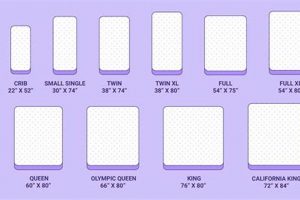
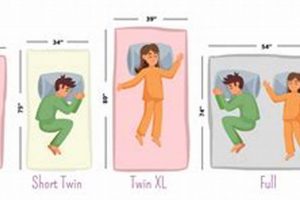
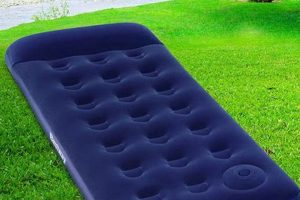
![Best Coleman Queen Size Air Mattress [Guide] Organic & Natural Mattress Buyer’s Guide: Non-Toxic Sleep Solutions Best Coleman Queen Size Air Mattress [Guide] | Organic & Natural Mattress Buyer’s Guide: Non-Toxic Sleep Solutions](https://mattressworldpa.com/wp-content/uploads/2025/07/th-2264-300x200.jpg)
